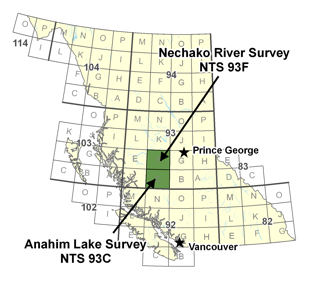Summary
The Anahim Lake (NTS 93C) and Nechako River (NTS 93F) surveys provide new geochemical data covering a number of highly prospective unsurveyed areas within the region.

There are over 60 base and precious metal occurrences in the Anahim Lake - Nechako River map sheets including several such as the 3T's and Clisbako, which have extensive exploration history. However, exploration for new deposits has been hampered by widespread glacial sediment and Miocene lava cover. During 2005 a total of 2070 drainage sediment and water samples were collected from 1957 sites covering 19,500 km2. Most of the samples were taken from lakes and analyzed for trace and minor elements by instrumental neutron activation and by aqua regia digestion - inductively coupled plasma mass spectrometry (ICP/MS), for loss on ignition (LOI) and for fluorine. Water samples were analyzed for pH, conductivity and fluoride. Survey data has been combined with the results of two previous lake sediment and water geochemical surveys completed near the Fawnie Range and around Ootsa Lake. Gold values up to 694 ppb and copper up to 1536 ppm have been detected in sediment samples.
While stream sediments are most commonly used for regional geochemical surveys in BC, the subdued topography, poor drainage and abundance of lakes in the northern Interior Plateau region of central BC make lake sediments an
appropriate geochemical sample medium in this area. Lake sediment surveys are an effective tool to delineate regional geochemical patterns and anomalous metal concentrations related to mineral deposits. The discovery of epithermal
precious metal prospects such as the Wolf, Capoose and Tsacha prospects, and porphyry base metal prospects such as the Mac deposit, are examples of the successful application of lake sediment geochemistry in this area.
Survey results provide the exploration community access to new geochemical information for under-explored areas of high mineral potential and will stimulate future exploration activities. The survey results were released in July 2006 and within three months 193,000 hectares were staked.